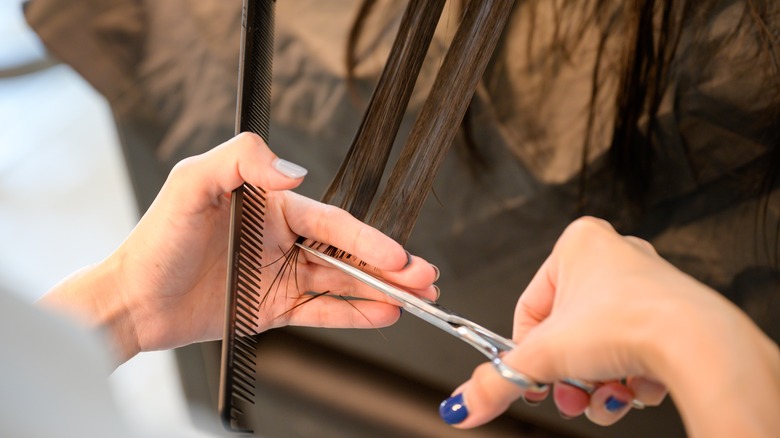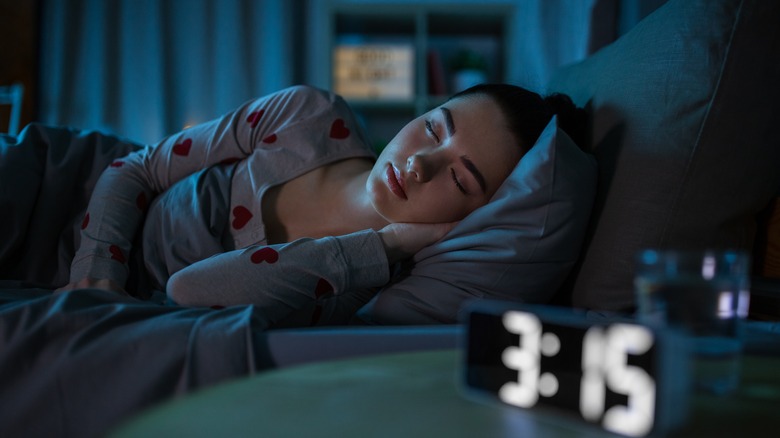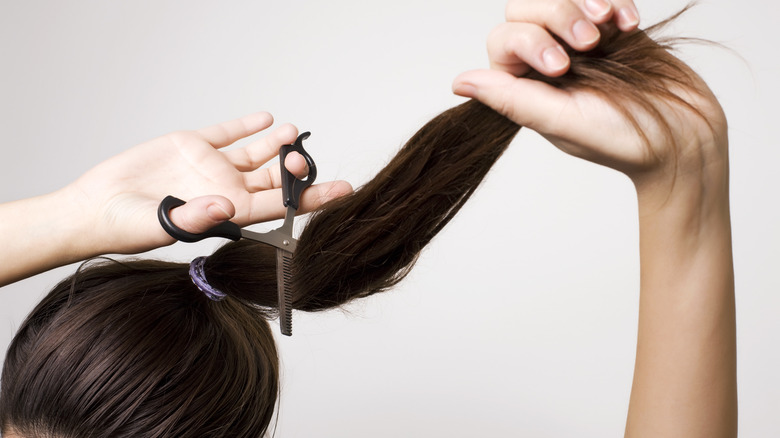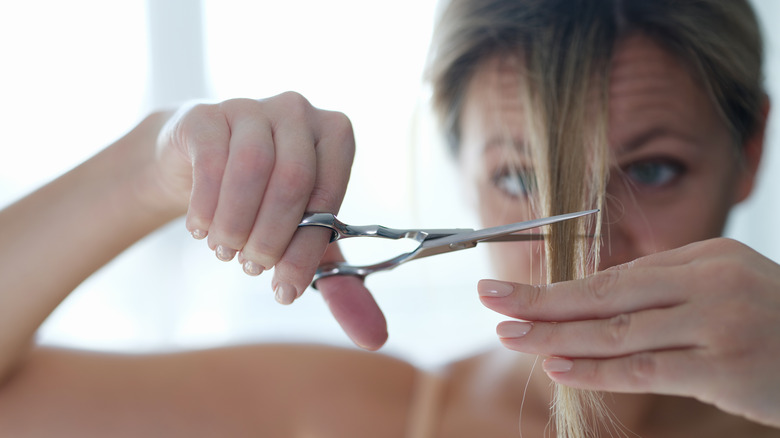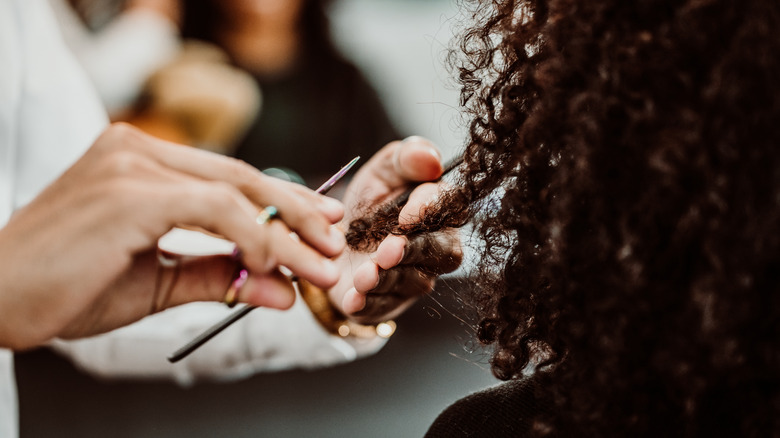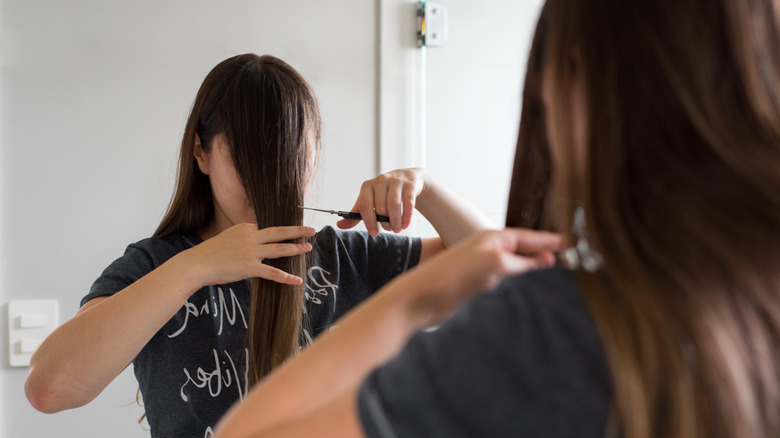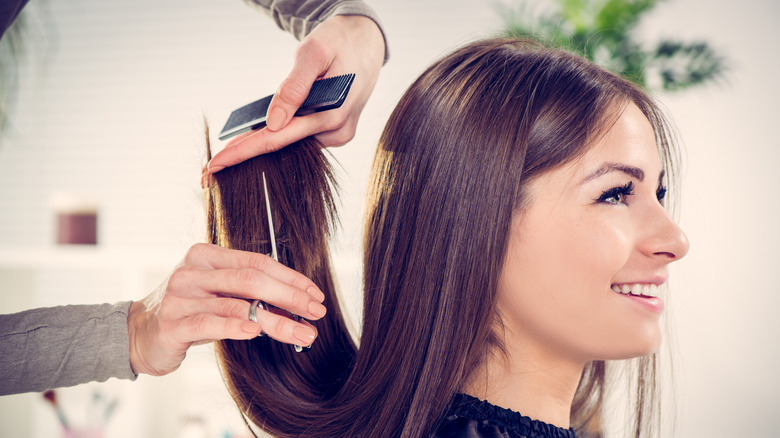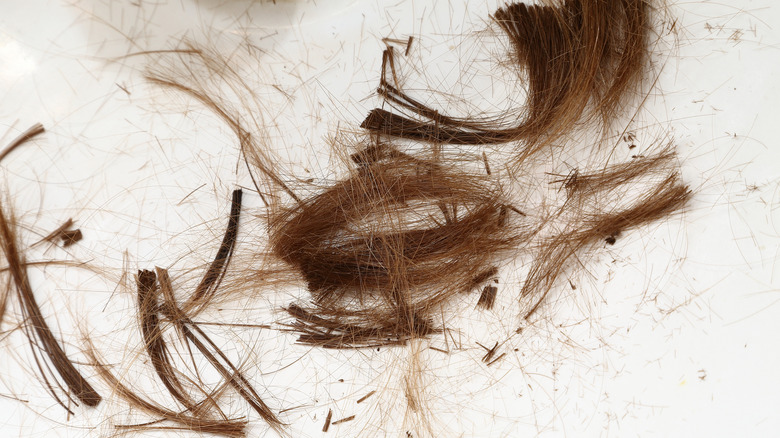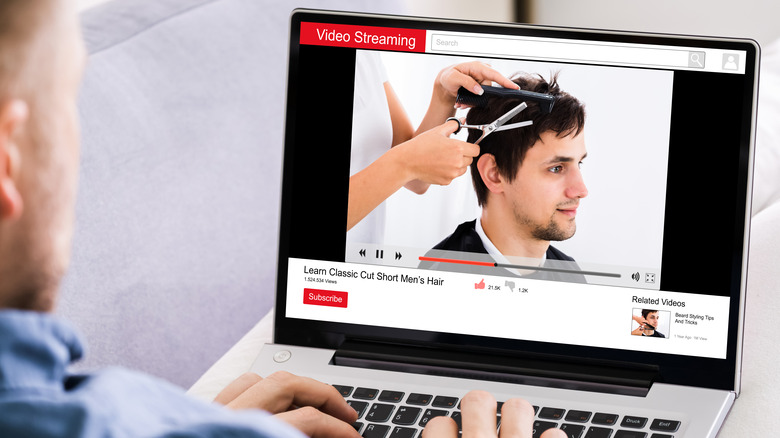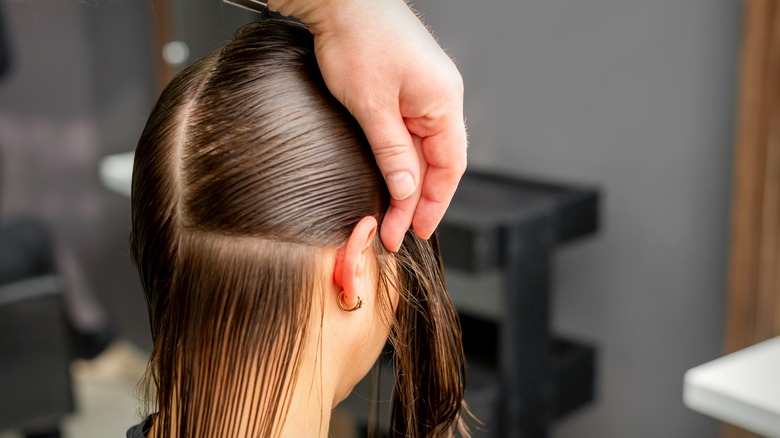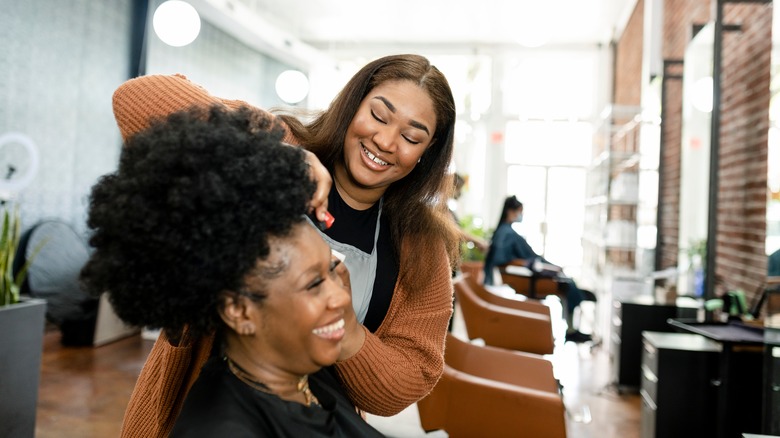What You Need To Know Before You Try To Cut Your Own Hair
If you're considering cutting your hair at home, you should be aware of a couple of things. "Hair cutting is an art form, but it also requires a lot of geometry," hairstylist Stephen Thevenot tells Cosmopolitan. "The most important thing is knowing what to cut and what to leave, and that comes with training and experience."
Having that said, it's okay to explore cutting your hair at home, especially if you take the time to research it and ensure you have all the tools ready. To help you get the best results, we explored what the professionals have to say about cutting hair and what you need to take into account before snipping your hair off. After all, those who learn the art of cutting their hair (or at least trimming their ends) will save quite a bit by not having to splurge on a hair salon visit every two months. Nevertheless, we do not recommend switching to at-home cuts in the long term; going to a professional has other benefits besides just getting your hair cut, but we'll get to those later. Now, let's get into everything you need to know about cutting your own hair at home.
The right scissors make a difference
While you can technically cut your hair with any scissors, getting professional haircutting scissors will make things easier for you and give you better results. "Don't use kitchen scissors," hairstylist Justine Marjan tells Allure. "They aren't sharp enough and can push the hair as they cut, resulting in crooked lines that are hard to fix." You don't need to invest in the most expensive professional haircutting scissors; you can often purchase an affordable pair at your local drugstore. However, if you're finding yourself cutting your hair at home repeatedly, consider getting a pair that's a bit more pricey. "If you're cutting hair at home, you should invest at least $100 in a really nice stainless steel blade," the creator of the Curly Girl Method, Lorraine Massey, tells Shape. While $100 certainly isn't a bargain, professional scissors cost up to $2,000.
"The reason stylists use shears versus the ones sitting in your junk drawer at home is that the sharp, precise blades allow you to be much more exact and make it easier to get clean lines and edges," hairstylist Andrew Fitzsimons explains (via Allure). Because professional scissors are better all around, you will not only cut your hair better but also get the job done quicker.
Don't cut your hair on a whim
It's easy to fall into the trap of seeing a new at-home haircut trend on TikTok and want to do one on yourself immediately. However, cutting your hair out of nowhere most commonly results in regrets. If you find a haircut you like, whether it's just adding bangs to your hair or doing something more elaborate like the viral butterfly haircut, you should sleep on it (preferably more than just once).
Another factor that often affects your desire to cut your hair is stress. When we're in a bad mood, we often look for a quick change that can help us feel better. Changing our hair is usually the most appealing option. "We never make our best hair decisions when we're stressed," hairstylist Angela Layng tells Wired. Needless to say, a haircut won't help really help solve your problems, so there's no reason to rush it.
Always cut less than you intend to
Here's the thing: you can always cut more tomorrow, but if you cut too much, you will have to wait months for it to grow out. The best advice for cutting your hair at home is to start with tiny trims. "Don't cut to the length you want the end result to be at first — start smaller and work your way up," hairstylist Andrew Fitzsimons tells Allure. "Remember, you can always trim more, [but] it is unfortunately not possible to put [hair] back once you've chopped."
The best way to go about it is to take a strand and cut it to your desired length. Once satisfied, you can replicate that with the rest of your hair. "You can see where the hair will land, then use that piece as a guide for the rest of the hair," hairstylist Justine Marjan recommends (via Allure).
Cutting your bangs is actually easy
One of the easiest haircuts you can give yourself is bangs. Yes, many things can go wrong, but since the front of your hair is easily visible and accessible, you have the highest chance of actually doing a great job. Of course, as previously mentioned, cut less than you plan to and see how it goes.
Be aware that taking too much hair for your bangs can result in super bulky ones. "Hold a comb flat on top of your head. Turn sideways towards the mirror so you can see where your head starts to round in the front," hairstylist Michelle Fiona tells The Cut. "That is your starting point for your bang section. Using a wide-tooth comb, separate your bangs from the rest of your hair by making a triangle shape."
If you're wondering how to get those thinned-out ends, hairstylist Nicole Hitchcock explained it to Prevention. "Twist your bangs and elevate the hair straight out from the scalp," she says. "Then cut into it rather than trying to cut a straight line. Otherwise, it's likely you'll fail horribly and end up looking like a kid. Instead, go for a textured wispy look — it's easier to achieve."
Cut your hair dry and straightened/styled
A lot of people believe that hair has to be cut wet, as most hairstylists do it that way. However, keep in mind that they are professionals and can visualize what the hair will look like once it dries. After all, they cut hair daily. If you're cutting your own at home, dry it and style it how you'd like to wear it, and after that, you can start cutting.
"Make sure hair is clean and blow-dried straight or how you wear it usually so you have a clear and realistic vision of the cut," hairstylist Justine Marjan tells Allure. According to her, this will help "avoid any surprises, like how much the hair will shrink up when it's dry." If you choose to cut your hair wet, keep in mind that it will look different once it's dry. "When hair is wet, it stretches, so you always want to take less off than you think to avoid cutting too much," hairstylist Meri Kate O'Connor tells Cosmopolitan.
Wavy and curly hair will look much shorter once it's dry
Hair, in general, will look shorter once it dries, but this is particularly true for curly or wavy hair. "Cutting curls always has a slightly different approach due to the hair's natural body and the way the hair sits differently from wet to dry," hairstylist Lucy Jones tells Glamour.
Because of this, getting a professional haircut is definitely a better option, as no curly hair is the same — and a professional can quickly assess where they need to cut for it to look its best. However, if you're determined to do it yourself, it's best to opt for layers. "Layered curls are a simple look that gives your hair a light, airy shape while adding volume and movement to those curls, and can work for all hair types," celebrity hairstylist Annagjid "Kee" Taylor tells Byrdie. Luckily, curly hair is much more forgiving when it comes to harsh lines, as they most likely won't be visible due to the hair's natural curling pattern.
The direction you cut in does matter
Another thing that many people don't consider is the direction they cut their hair. "Point the scissors upwards and lightly open and close scissors on the ends of the hair," hairstylist Justine Marjan explains to Allure. "This is a point-cutting technique that gives a more diffused finish on the ends." If you cut your hair straight across, you will be left with sharp lines, or even worse — ones that turn out wiggly. "Try point cutting instead of blunt cutting across to soften the ends unless you're going for a super blunt fringe," hairstylist Cherilyn Farris tells Byrdie.
Bluntly cut bangs are luckily super easy to fix — all you need are sharp haircutting scissors. "Going in [with your scissors] about one to two centimeters will help blur the line. If you go in farther than that, you will begin to thin your bangs out," hairstylist Deana Morton adds (via Byrdie). "Thinning your bangs out will make them appear textured, help them stay to one side more easily, and give you control. If you choose to thin your bangs out, use the smallest and sharpest scissors you have and always start with less."
If you still feel like you have sharp lines, wash your hair and style it — sometimes, that's all it takes to make the sharp lines disappear. "Blowing out your hair or using a brush to dry around the face can help blend mistakes. Using a good air-dry creme and manipulating damp hair how you want it to dry can encourage how you want your hair to lay," Farris recommends.
Having a friend or family member help can make a huge difference
If possible, it's great to have someone with you when you're cutting your hair at home. Even if they don't participate in the haircutting process, they can still help you by pointing out spots you should fix. Since you should sleep on it anyways, inviting a friend over and planning the haircut properly with them can help you prepare better and get good results.
"Cutting your own hair is always hard to do; this is why I do not recommend it," hairstylist Tracy Folino tells Allure. "However, if you can get some help, it will make it a lot easier." If you have already cut your hair but are unsure how good it turned out, have someone help you afterward. "Ask them to go over the same area a few times to ensure a cleaner cut," barber Rob Louden recommends (via Allure). "If you don't have that second hand to help or don't have a second mirror, I tell people to outsmart the smartphone and use the selfie camera. Use it as a mirror when doing the back of your hair in front of your bathroom mirror."
Never cut hair in a rush — plenty of time is crucial for a good outcome
Apart from giving yourself enough time to think the haircut through, it is also essential to give yourself enough time to actually execute it. This means that you shouldn't cut your hair at night after a day of work — a tired you will surely not do the best job. Besides being well-rested and in a good mood, you also need to consider that you will need plenty of time to cut your hair, as rushing is a big no-no.
Per Behind The Chair, taking 45 minutes for a haircut is acceptable for a hairstylist, but those cutting their hair at home should double the time. This means that unless you have two hours, don't even attempt to cut it. Of course, this does not apply to trimming bangs, as that can usually be done in under 30 minutes, especially if you have already done it a couple of times.
Video tutorials are your best friend
While you can read about how to cut your hair, the most useful approach is actually seeing it. Luckily, there are a plethora of haircutting tutorials on social media platforms like YouTube, TikTok, and Instagram. Pick the hairstyle you want to have, take into consideration your hair type, and starting from there, take some time to watch multiple videos to see how you can execute it.
"Find someone who has a cut similar to what you're looking for and make sure they have a similar hair type," hairstylist Andrew Fitzsimons suggests (via Allure). Apart from watching a tutorial prior, it's also helpful to have it on while you're actually cutting your hair. This way, you can ensure that you don't miss any steps. And if it's a tutorial that ends up helping you get a great haircut, make sure you bookmark it for the future.
Hair sectioning is essential
While you might be tempted to just cut your hair while it's all down — you absolutely need to section it, no matter how thin it is. "It helps you focus and will help you trim to the same length in each section," hairstylist Kamara Brown Lewis tells Cosmopolitan. For the sectioning, you'll need hair ties or clips.
The most common way to section your hair is into four parts. First, separate your hair from ear to ear, and put the upper half in a clip (or tie it). After that, split the lower part into half so you can bring it forward on each side. A proper separation into sections will make the whole process much easier, which is why you should take advantage of this step. Even if you're just cutting your bangs, make sure to separate the rest of your hair from them so that you don't mistakenly cut a piece you shouldn't.
Major changes are best left to professionals
We already established that cutting your hair at home is possible, especially if you prepare well. However, certain haircuts are better left to professionals, as they are challenging to execute. Trimming ends, cutting layers, or shortening bangs are all considered to be on the easier side, but sharp, blunt cuts, asymmetrical cuts, or cuts that require cutting a lot of length off are some of the ones we advise you leave to a hairstylist. "Don't try anything new or different; wait for your stylist and be patient," hairstylist Jerome from the Pierre Michel Salon in New York City tells Health. Once you invest in a professional haircut, you can maintain it at home.
Apart from getting a haircut, making sure you visit a professional is also crucial for your hair's health. A good hairstylist will immediately notice if your hair or scalp is unhealthy, and they should let you know. This can prevent any conditions from worsening and resulting in hair loss. A good hairstylist will also give you advice or let you know if you ever need to see a dermatologist.
It's okay to trim your ends at home
After about eight weeks, you can trim your ends by following the haircut you already have. Again, even for something as simple as trimming, ensure you have enough time and, if possible, a helping hand. "Ideally, you don't want to go past eight weeks," hairstylist Nick Stenson tells The Zoe Report. "Eight weeks is about the furthest you can go without compromising the health of your hair. If you have a heavily layered or a short haircut, going past six weeks will make it hard to keep any shape build into the haircut."
Giving yourself a haircut at home might seem impossible, but getting rid of split ends is perfectly doable. If you're unsure whether your hair is ready for a trim, examine it by touching it from root to end. If you notice a change of softness towards the end, that tends to be a sign your hair is ready for a trim. "Split ends are much easier to detect in straight hair, as curly and coily styles can often mask the true state of hair ends," hairstylist Robin Groover reveals to The Zoe Report. "However, hair that becomes stuck or tangled when running your fingers through it is often an easy detector of split ends. The split ends create knots for curls and coils on the ends. And as a result, the hair will often break on the ends, resulting in length stagnation."
Now, with these tips, how do you feel about chopping your tresses from the comfort of your own bathroom?

